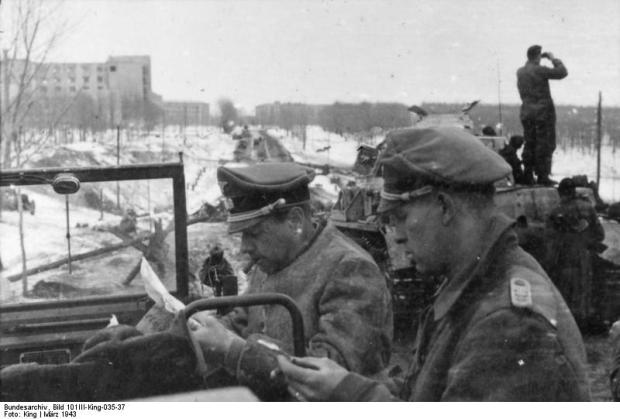
The case of Kurt Meyer is somewhat disturbing for it may well have been the 1st case of “Political Correctness” and it also puts question marks on how sorry the Germans really were after WWII.
Kurt Meyer (23 December 1910 – 23 December 1961) was a high-ranking member in the Waffen-SS of Nazi Germany who commanded SS Division Hitlerjugend during World War II. He participated in the Battle of France, Operation Barbarossa, and the Battle of Normandy, among others, and was a recipient of the Knight’s Cross of the Iron Cross with Oak Leaves and Swords.

Meyer was convicted of war crimes for his role in the Ardenne Abbey massacre, the killing of Canadian prisoners of war in Normandy.

In the early days of the Normandy campaign 20 Canadian soldiers, members of the North Nova Scotia Highlanders and 27th Armoured Regiment (part of the Sherbrooke Fusilier Regiment), were captured and executed by Waffen SS forces in a monastery, near Caen, France. The incident was a direct violation of the Geneva Convention, which was signed by Germany before the war.
The executioner was the infamous SS Standartenfuhrer, Kurt Meyer. Meyer was in charge of the 25th Panzer Grenadier Regiment and under its wing, the fanatical 12th SS Panzer Division Hitlerjugend. The Hitlerjugend Division was comprised of ex-members of the Hitler Youth, who were sent to Caen to participate in combat against the invading Allies.

The captured Canadians were all young men, barely out of school, with no combat experience. They were outmanoeuvred and captured in June 1944. The headquarters of the 25th Panzer Grenadier Regiment was located in the Ardenne Abbey, so the soldiers were taken there.Their bodies were discovered on July 8, 1944 after the Abbey had finally been liberated by the Canadian Army. First, they found the body of Lieutenant Thomas Windsor

Meyer was held as a prisoner of war until December 1945, when in the town of Aurich in Germany he was put on trial for war crimes, charged with the murder of unarmed Allied prisoners of war in Normandy.

He was sentenced to death, he appealed the sentence but the appeal was denied by General Christopher Vokes.

However, due to a technicality discovered by a prosecutor the death sentence was commuted to one of life imprisonment.Meyer was transported to Canada to begin his sentence.Meyer served five years in Dorchester Penitentiary, in New Brunswick, Canada where he worked in the library and learned English.

Meyer petitioned for clemency in late 1950 – somewhat surprisingly including an offer to serve in a Canadian or United Nations military force if released; the government was willing to let him return to a German prison but not to release him outright. He was transferred to a British military prison in Werl, West Germany in 1951.
He was released from prison on 7 September 1954 after the German government reduced his sentence to fourteen years and for good behavior, was determined to be eligible for release. Upon his return to Germany in 1951, Meyer told a reporter that nationalism was past and that “a United Europe is now the only answer”
Upon his release from prison, Meyer became active in HIAG, the Waffen-SS lobby group, formed in 1951 by former high-ranking Waffen-SS men, including Paul Hausser, Felix Steiner and Herbert Gille.

Meyer became the organization’s spokesperson in 1959. He was considered one of the leading Waffen-SS apologists. At a HIAG rally in 1957, he announced that while he stood behind his old commanders, Hitler had made many mistakes and it was now time to look to the future, not to the past. Speaking before some 8000 SS men at the HIAG convention in Karlsberg, Bavaria, in 1957, he proclaimed that “SS troops committed no crimes, except the massacre at Oradour, and that was the action of a single man”. He insisted that the Waffen-SS was “as much a regular army outfit as any other in the Wehrmacht.”
His memoirs, Grenadiere (1957), were published as part of this campaign and were a glorification of the SS’s part in the war as well as of his role in it. The book detailed his exploits at the front and served as an element of the Waffen-SS rehabilitation efforts. Meyer condemned the “inhuman suffering” that the Waffen-SS personnel had been subjected to “for crimes which they neither committed, nor were able to prevent”. Historian Charles W. Sydnor referred to Grenadiere as “perhaps the boldest and most truculent of the apologist works”. The book was part of HIAG’s propaganda campaign to promote the perceptions of the Waffen-SS in popular culture as apolitical, recklessly brave fighters who were not involved in the war crimes of the Nazi regime.
These notions have since been refuted by historians.
In his later years he was afflicted with poor health, needing a stick to walk, and suffering from heart and kidney disease.After a series of mild strokes, he died of a heart attack in Hagen, Westphalia, on his 51st Birthday 23 December 1961. Fifteen thousand people attended his funeral in Hagen, a cushion-bearer carrying his medals in the cortege.


Reblogged this on History of Sorts.
LikeLike